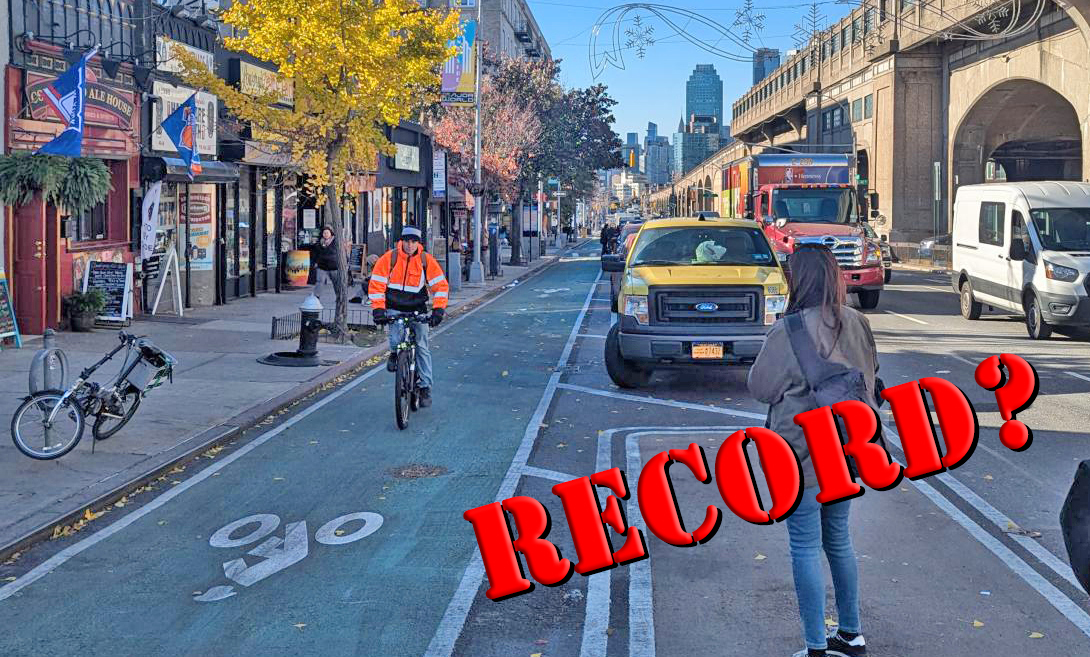Everyone knows that public transit, not auto travel, is New York City’s transportation workhorse. Thus it was a little unsettling to get halfway through the ostensibly transit-friendly story in today’s Times, "Take a Taxicab to Work? More New Yorkers Walk," and read that mass transit doesn’t even account for half of the city’s commuting.
The full quote appears after the helpful lede reporting that 10 times as many New Yorkers walk to work as take taxis:
A higher proportion -- nearly half -- of New Yorkers take mass transit, more than in any other city in the country. Nearly 37 percent use the subway and 11 percent commute by bus.
Not even half of us commute via mass transit? Not so, which the veteran reporter Sam Roberts, the paper’s resident NYC historian and demographics buff, could have seen by turning over the numbers he drew from a March report [PDF] by the city-financed Center for Economic Opportunity:
- Roberts failed to adjust the report's percentages (which appear on page 81) for the nearly half-a-million commutes whose mode was unidentified. Remove them from the denominator and the share of identified work trips made by subway or bus goes from 47.6 percent to 53.3 percent -- a majority.
- Trains (commuter rail) and ferries qualify as mass transit just as much as subways and buses. Add their shares to subway and bus, and mass transit’s percentage of NYC commuting rises by two points to 55.3 percent.
- Most transportation planners nowadays place walking, cycling and telecommuting together with transit under the rubric of "green modes" -- a term popularized by the British sustainable transport expert Rodney Tolley in his 2003 anthology, Sustainable Transport: Planning for Walking and Cycling in Urban Environments. Aggregating the green modes' shares in the CEO data, they account for 69.9 percent of New York City commuting.
See this simple spreadsheet for the various percentage breakdowns. The real finding is that between two-thirds and three-fourths of our work trips are made without an automobile. If you’re curious, the 30 percent non-green share breaks down thus: drive solo, 23.6 percent; carpool, 5.5 percent; taxi, 1.0 percent; motorcycle, 0.0 percent (actually, 0.048 percent). Bottom line: Non-car commuting outnumbers car commuting by more than two-to-one.
Also of interest are the CEO report’s data on commute costs. The $48.47 weekly mean cost to drive alone to work translates to a daily cost of around $10; subtract gas, applicable tolls and depreciation, and the implied cost to park may be less than $5 a day. This suggests one or both of two things: even in New York, where the astronomical cost of land is reflected in everything from rent to the price of food, parking continues to be the heavily subsidized exception; or the data in the CEO report don’t include parking, period, as one informed commenter has suggested.
Another angle absent from Roberts's story is the delay costs each commute trip imposes on other travelers by taking up street space and slowing down other traffic. Of course, these vary greatly depending on time of day and location. I’ve estimated that during the morning rush period, each mile driven by a single car slows other traffic to the extent that all road users in the Manhattan Central Business District (other drivers, truckers, and bus passengers) collectively lose time worth $16. (The delay cost per mile driven outside the CBD is $3.)
True, some aspects of green-mode commuting also impose time costs on others -- think of the delays caused by bus riders swiping MetroCards, subway passengers holding up the closing doors, or cyclists slowing down other traffic. Further quantification awaits, but these costs almost certainly average at least an order of magnitude less, per trip, than commuting by car.





